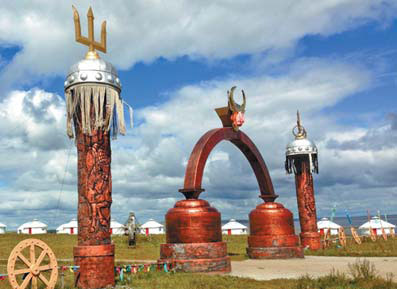Quiet frontiers
|
The entrance to the Hohnur riverside resort. Cang Lide / China Daily |
The city's demographics reflect historic influences. While more than 90 percent of Manzhouli's inhabitants are Han Chinese, there are also Mongolians, Buryat Mongolians, Manchus and Russians.
Some Russians migrated here several generations ago and have Chinese names, Chinese spouses and very little of their mother tongue. The only betrayal of their origins is probably their sharper facial features, "especially the nose", says our guide Xiao Zhao, whose husband is the descendant of a Russian trader.
She tells us he no longer speaks Russian, although he has a grandmother who still cooks him Russian bread and borscht, the famous root vegetable soup served with sour cream.
At the largest and probably only international class hotel in town, guests are welcomed with a bread and salt ceremony at the Shangri-La Manzhouli, in a colorful display of tradition.
The hotel's young executive sous chef also manages a pretty authentic Russian menu, with shashliks (traditional kebabs), beef stroganoff and a pickled herring terrine taking pride of place.
Manzhouli's night scene, too, mirrors the influences, with nightspots and restaurants catering to Russian tour groups.
They come specifically for vodka and entertainment - especially live shows at such opulent restaurants as Maxim's, featuring Chinese and Ukrainian singers, acrobats and magicians.
But the dwindling trade between China and Russia is already showing its aftermath, and the glitzy nightlife is now attracting more tourists from other Chinese cities, with bigger wallets and a greater willingness to spend.
Signs in the city are often in four languages. Because this is the Inner Mongolia autonomous region, Mongolian is an official language, with Chinese and English also visible everywhere.
But at the heart of the action, along the Third and Fourth Avenues, the neon lights are still all in Russian.
In terms of architectural influences, there are wooden cabins and stone cottages that look more at home in the steppes than on the grasslands, and grimly uniform Soviet-style buildings make their presence felt. Huge orthodox churches dot city corners but have been mostly converted into secular use.
The city also holds a Guinness World Record for having the world's largest matryoshka, the Russian doll. It is a 30-meter-high construction inside of which shops sell the actual dolls, all carefully tucked inside each other in increasingly smaller sizes.
The outside of the huge taowa, as the Chinese call it, is painted with the images of three dolls, each respectively dressed in Chinese, Russian and Mongolian attire to represent the cultural demographics.
Manzhouli's Taowa Square is a popular tourist site. The square itself features brass statues of the 12 Chinese zodiac animals as well as sculptures from various fairytales and other icons of moral examples.
To attract a better tourist profile, the town had also built a dusty red cathedral-like building on a hill that allows visitors a vantage from which to view the town. This is Manzhouli's famous Wedding Chapel, which intends to attract couples to hold their marriage ceremonies here.
Besides the glitzy, exotic dollhouse buildings in Manzhouli and its rambunctious nightlife in Russian restaurants, coal mining is a thriving industry. Petroleum and other valuable natural resources have been discovered in the last 20 years.
Tourism is slowly shifting focus toward the area's natural environments.
In the right season, it's a bird-lovers' paradise, offering sightings of hundreds of thousands of cranes, wild geese, bustards and other migrating species on the vast wetlands along the rivers. Anglers, too, are attracted by opportunities to fish in the region's hundreds of lakes and rivers.
At the riverside resort of Hohnur, modern yurts equipped with TV sets welcome visitors, and there are thoughtful hygiene facilities set up all along the roads and at scenic locations for those important bathroom breaks.
- Exotic experiences in border cities
- Border tourism keeps on developing steadily in Manzhouli
- Take a ride to Manzhouli and dismount
- Tale as old as the grassland
- The first "Anduo Ranch" culinary competition held in Beijing
- Xinjiang: another charm
- Snow-covered Xilin Gol grassland in China's Inner Mongolia

















